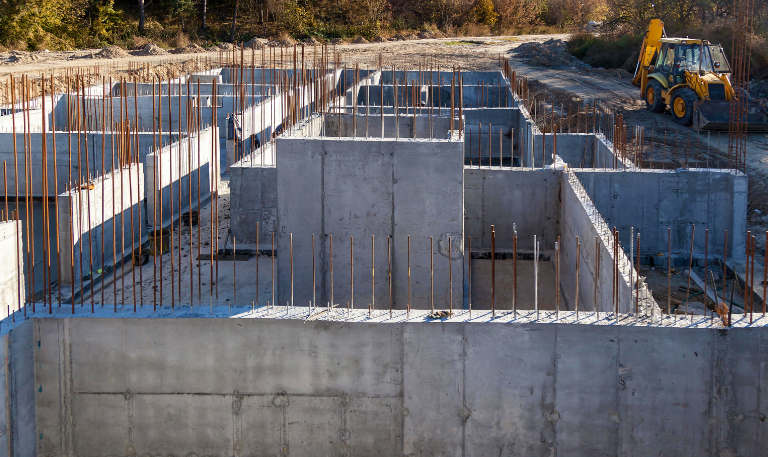Key to Fiberglass Rebar Success- Bond Strength
Concrete by itself is great under compression, but weak under tension (about one-tenth as strong). This becomes a problem in concrete construction, to which there are two basic ways to address:
- Plain Concrete-The Romans got around this problem by thickening their concrete—the walls of the Pantheon are 20 feet thick. This makes for a lot of material and heavy structures (read: expensive), but functionally works quite well.
- Reinforced Concrete– A composite material—meaning it is a combination of two materials—consisting of concrete and reinforcing bar. Add in steel reinforcement, which has good tensile strength and voila you have a single building material with compressive and tensile strength. As you are probably well aware, this is the preferred strategy of modern construction.
Reinforcing material has largely been focused on steel, because there are few materials that could compete on performance (tensile strength), price, and availability. Until now.
Bring on the Fiberglass
The introduction of glass fiber reinforced polymer (GFRP or fiberglass rebar) has led to materials that have significantly higher tensile strengths (2x-3x) that are competitive on price, and widely available compared to black steel. With these benefits codes (ACI 440.11-22, IBC 2024) have been quickly adopted that allow the engineer to choose between steel and fiberglass for the reinforced concrete.
However, in the drive to get the highest tensile strength, we have overlooked the key element that because reinforced concrete is a composite material these two materials need to work together. They need to be bonded to each other. We aptly call this value: Bond Strength.
A Detour on Deformation
When concrete was first being reinforced into steel, the two materials had weak bond strength. Contractors used to take smooth steel rod and twist it in the field to get higher bond strength. Manufacturers quickly realized the challenge of this method, and introduced integral deformations (basically roughened surfaces). This increased the steel’s bond strength 10x, and the rest is history…
Being a smooth material, GFRP inherently suffered the same problem and manufacturers started to relearn this. First by roughening the surface with sand, and then by introducing their own integral deformations. But these values differ greatly from manufacturer to manufacturer as in Table 1.
Table of Bond Strength to Concrete (sources at bottom)
| Bar | Average Bond Strength (psi) | Range Bond Strength (psi) |
| MST Bar | 3,100 | 3000-3300 |
| Deformed Steel | 2,175 | |
| VROD | 2,029 | |
| Galen | 1,475 | 1100-2000 |
| GatorBar | 1,400 | 1400 |
| PinkBar+ | 1,300 | 1100-1400 |
| Mateenbar | 1,160 | 1160 |
| GFRP Code | 1,100 | |
| Plain Steel | 290 |
One Bar to Bond Them All- MST Bar
Only 1 manufacturer has been able to recognize this marker in the sand and beat steel: MST Bar. Their bar’s bond strength is 50% higher than steel; and nearly 200% higher than the code minimum. Simply put it yields a better reinforced concrete. Bond strength is so high, that MST Bar-reinforced concrete performs in a class by itself.
Designing with High Bond Strength
Accounting for the higher bond strength to concrete, yields further benefits:
- Embedment lengths can be reduced
- Lap lengths can be reduced
- Reduces (and often avoids) the need for adhesive or bent anchors bars
- Reduction in crack width
- Better fire resistance
- As a non-corroding material: Epoxy coating (and the concomitant loss of bond strength) can be ignored; Rusting and the breaking of the bond can be ignored.
Ready to Step Up to MST Bar Fiberglass Rebar? Shop our E-Store Today
Sources
Shunmuga Vembu, P.R.; Ammasi, A.K. A Comprehensive Review on the Factors Affecting Bond Strength in Concrete. Buildings 2023, 13, 577. https://doi.org/10.3390/buildings13030577
American Concrete Institute. Recommended Practice Guidelines for FRP Bars in Pre-Engineered Projects. MNL-6(23) https://www.concrete.org/store/productdetail.aspx?ItemID=MNL623&Language=English&Units=US_Units
American Concrete Institute. 2017 ACI FRP Composites Compteition: Reinforcement Identification Guide and Product Datasheets. https://www.concrete.org/Portals/0/Files/PDF/Reinforcement%20Identification%20Guide%20and%20Product%20Datasheets.pdf

VP of Business DevelopmentAaron Fisher
Latest News

4 Ways To Reinforce Concrete
Concrete is one of the most fundamental materials used in construction. If you’re working on a domestic project or a […]

The Environmental Benefits Of Using Ready-Mix Concrete
The construction industry is changing quickly to meet the growing demand for sustainability and eco-friendly practices. One of the most […]

6 Essential Tips For Grouting Stone Veneer
Grouting stone veneer is an important step in the installation process that can significantly impact the overall look and durability […]

Should You Fill Hollow Concrete Blocks?
Hollow concrete blocks are widely used in construction due to their strength, versatility, and lighter weight compared to solid blocks. […]
